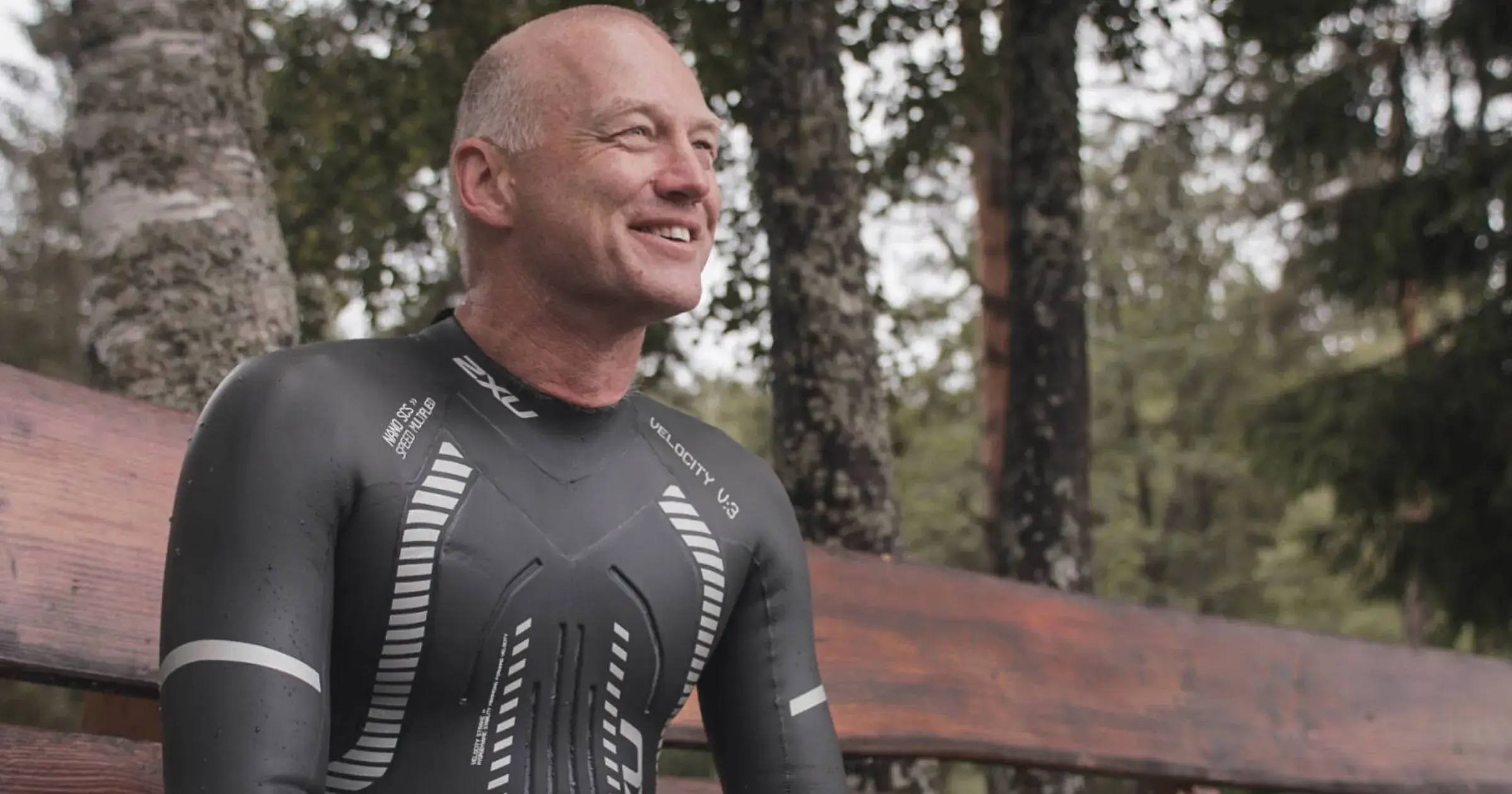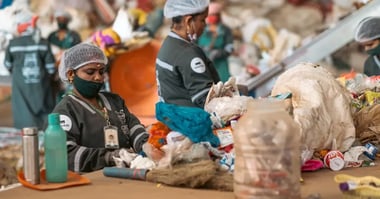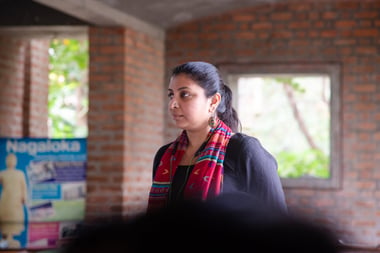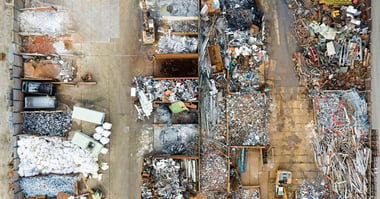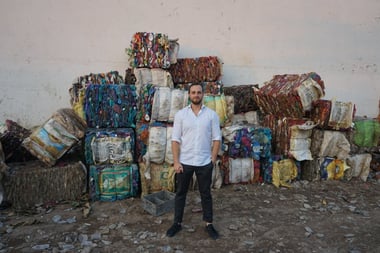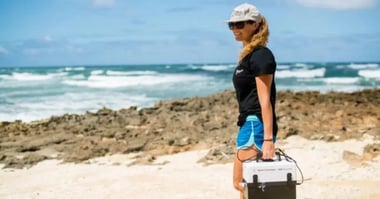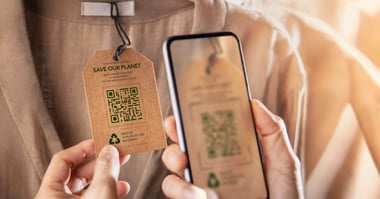Professor Andreas Fath is a German Chemist, specializing in wastewater treatment and surface technologies. More recently, his work has been focused on microplastics and the different methods to improve water quality.
As well as this, Fath is a passionate swimmer. He's even attracted international attention after swimming the entire Rhine River (in Germany) and the Tennessee River (in the US) to raise public awareness of plastic pollution in water streams.
Whilst also working on microplastics, dr. Fath is training for an upcoming large swimming project that is planned for summer 2022. During the "CleanDanube" project, Andreas Fath will swim 2,857 km from the source of the Danube to its mouth in the Black Sea. He will be accompanied by technically equipped boats that will examine the river water for plastics.
To get a deeper insight into his work, we had a chat with Dr. Fath — here's what he had to say.
.jpeg?width=840&height=430&name=Andreas%20Fath%20testing%20(1).jpeg)
Q. You specialize in microplastics, but what exactly is your key focus?
A. My main concern is actually the surfaces of microplastics. They are, let's say, parking places for other trace compounds, like pesticides, pharmaceuticals, antibiotics, or hormones. We find them in our rivers, released from sewage treatment plants, from industry, and from households.
In combination with strong rainfalls, there's a lot of water volume that's not treated in wastewater sewage treatment plants because of the pools they have.
The treatment plants are too small to catch the entire water volume which runs to them. This means the fish, shells, and all marine creatures we consume, eat these polluted microplastic particles. So their guts, their digestive systems, as well as their fatty areas, are full of particles that contain hormones.
And 75% of the worldwide population consumes proteins out of seafood. So, that's some of the basic concerns I have that our nutrition line is in danger.
Q. It can’t be healthy to ingest plastic, what happens to it after it has entered our bodies?
A. We know that plastic particles are released from our bodies after about 24 hours because we are not capable of decomposing the polymers. That's a known fact.
And this is the good news at the end of the day, we release the plastic we eat. But we don't know what these plastics carry on their surfaces and what they bring into our bodies like a Trojan horse. That's something uncertain and concerning.
Q. What are the sources of microplastics — and is there a broad categorization?
A. There is a top 10 list of microplastic-releasing sources, and the biggest source is tire friction, which is 2,260 grams per person per year. Then there is the abrasion of shoes, and, of course, littering.
The modification or transformation from macroplastic to microplastic in nature, is based on littering. This is a mechanical process, supported by UV light, which makes the plastic brittle.
Another big source under the top 10 is laundry. A lot of fibers are released during laundry. And of course, there are smaller sources.
Let’s take a salt shaker for example. There are some with an integrated plastic mill. If you take some grams from it you can analyze the microplastic particles on the filter.
So, if you think about this, it's realistic that we have an intake of five grams of microplastic in one week.
Q. You managed to give the entire topic quite some awareness by swimming. Can you tell us about your past adventures?
A. If you need attention, you have to do something crazy — and I combined my two passions, swimming and water analysis.
The first river I swam was the Rhine in 2014, from its source in Lake Toma in the Swiss Alps all the way down to the North Sea. It took me 28 days, and we analyzed microplastics along the way.
There are no people living at Lake Toma, there is no industry, and no cars are driving there. This is up in the Alps at 2,340 meters altitude, but we still found microplastic in that lake. And we found perfluorinated tensides in that lake.
So far away from civilization but you still find polluted water.
The explanation is that the lake takes its water from melting snow. The snow contains microplastic as well as other pollutants, which come from the cities.
Some months later, an American researcher who investigates the Tennessee River called me saying: “Oh, it's almost the same quality of the water here.” And at the end of the day, we came up with the idea, “Well, why don't you swim the Tennessee River in the same way you did the Rhine?”
So, in 2017 I swam the Tennessee River. The interesting part for me as a chemist was that even though the lengths of the two rivers are comparable, the wastewater impact is different. 48 million people release their wastewater to the Rhine, and only 4.8 million to the Tennessee River.
"If you need attention, you have to do something crazy — and I combined my two passions, swimming and water analysis." — Dr Andreas Fath
The chemistry from the rivers tells you something about the lifestyle of the people living along the river. The river tells you the story — how people manage their waste, what the hospitals use, and if they have a system of separating their paper, plastic, and organic food.
You can see all of this from the composition of the chemical cocktail in these rivers.
My upcoming adventure will be swimming through the Danube next year. This is the biggest challenge I have faced so far because it's the double length of the Rhine, and it passes through 10 countries — so 10 different influences on the water quality.
This time, we will look more into the depth of the river, searching for plastic there. You find 90% of the plastic in deeper areas, not on the surface of the river. And we want to calculate how many tonnes of plastic run down until the Black Sea.
"There are no people living at Lake Toma, there is no industry, and no cars are driving there. This is up in the Alps at 2,340 meters altitude, but we still found microplastic in that lake. And we found perfluorinated tensides in that lake. So far away from civilization but you still find polluted water." — Dr. Andraes Fath
Q. What is the solution to plastic pollution in our waterways — and what can we each do to prevent it?
A. Let me say it with the words of a famous Jack Johnson song: the three R's - reduce, reuse, recycle.
So, the first thing is how we can reduce our plastic consumption — going shopping in a controlled way and bringing your own bags with you is the first step. Monitoring your own plastic waste production can be helpful as well.
In Germany, we have the yellow bag for recyclable plastics, and every four weeks, I have to put them outside so they will get picked up.
We are a 5-person household and I realized: “I have four bags every four weeks, that's a really huge amount of plastic litter!” Only by thinking and looking at how I can reduce my waste production, I reduce it by 50% to only two bags, and our life quality is not reduced. So why do people still cover their bananas with a plastic bag? That's stupid.
There are so many stupid products on the market which you don't need.
So, the big point is, at the end of the three Rs, there is the recycling step — and we have to increase this amount dramatically. From the 8.6 billion tons of plastics we have produced since 1950, we have only recycled 9%.
12% was combusted and the other 79% has leaked into nature, into fish stomachs, enclosed in the Arctic ice, at our beaches, wherever. And if we don't increase the recycling part, then we would have produced 34 billion tons of plastic by 2050.
Imagine that — four times more plastic outside there than now. And if you look at the Great Pacific Garbage Patch, and this multiplied by four, I don't want to see that.
So, we have to react earlier. We were too late in the pandemic, we were too late in the climate change. I don't want to be too late in our plastic waste treatment system.
Want to discover more ways to cut back on plastic? Check out our helpful guide on How To Reduce Plastic At Home.
Summary
We'd like to thank Dr. Andreas Fath for taking the time to talk to us about his incredible journey. Not only are his adventures inspiring, but hugely informative — benefiting us all on the topic of microplastics.
Continue learning about plastic waste by checking out some of our similar articles below:

